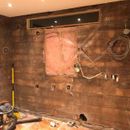Air sealing an old, leaky wall
My mother-in-law is renovating her kitchen and the contractor just opened up the exterior wall today. Her house is about 100 years old, in Climate Zone 6. The wall assembly is brick, airspace, unknown exterior sheathing, true 4″ studs with some loose filled insulation (probably hazardous if disturbed…), board sheathing, and some poly someone added in a previous renovation. The current plan is to remove the beat up poly and replace it, and leave the boards and insulation in place and put new drywall on.
She mentioned there is always a draft from that wall in the winter, so I thought it might help to try to improve the air sealing while it is open from the inside, but I am not sure of practical solutions to reduce air movement through that wall.
Could it be done with 6-mil poly and tape? Could they do air-tight drywall over board sheathing? Blueskin the whole thing on the inside? She has a fairly diligent contractor who does nice work, but I am not sure he is familiar with green or high performance building techniques. I suspect he would be open to ideas though if I can communicate them clearly enough, and the materials can be sourced easily…
Obviously this is only a small piece of the house, but any ideas or thoughts would be appreciated!
GBA Detail Library
A collection of one thousand construction details organized by climate and house part










Replies
James, there was a whole discussion about the very same wall a month or so ago here but I can't find it now. Most agreed to put a denser and higher R value hardboard foam in-between the studs and air seal with canned foam. Then R-11 batts inboard of that somewhat compressed.
The interior sheathing is an interesting detail. I wouldn't keep the poly. I would replace with a smart vapor retarder line MemBrain if needed for code compliance. Detailing that (or the drywall) as air barrier is good, but you have a lot of other things to worry about: air sealing electrical boxes, what air leakage could there be at the floor?, and what air leakage is there at the ceiling?
I like the idea of an NGX XPS foam tucked to the interior surface of the exterior sheathing, and air sealing around each perimeter. I’d aim to exceed the recommended ratio of the notional exterior insulation R vs total wall insulation R (I think that’s 50% in zone 6).
In the interests of simplicity, I’d aim to use a mid class 2 vapor retarding primer rather than an adaptive membrane, but that could be my warmer side of CZ5A expressing itself.
Furring the wall to the inside ( horizontal 2x4s? Let’s you put 2” foam against the interior of the outside sheathing and 3 1/2” batts inboard. That allows Type 1 EPS foam in conjunction with standard 2x4 stud void mineral wool batt. And no fiddling with a separate membrane.
I’d keep all utilities inboard of the interior sheathing- every kitchen counter needs an accessory shelf 6” above the counter with outlets underneath - or a pentagonal box out under the cabinets with outlets along it’s length ... or air seal the boxes when they are installed conventionally.
+1 on the Patrick's air barrier detailed MemBrain recommendation in lieu of polyethylene. The installation instructions are pretty easy to follow. Blueskin would make it reasonably air tight, but you'd then need to use vapor barrier latex to lower the vapor permeance.
Why is it presumed that the existing loose fill insulation is hazardous?
Early 20th century rock wool with a lot of iron slag content doesn't look as clean as late 20th century or newer rock wool, but it's not particularly hazardous. The material isn't toxic, and unlike fiberglass the fibers & dust are big & dense enough to not hang in the air for hours. If it's not a wool, but rather poured-in place asbestos-bearing vermiculite (shiny granular flakes) it's probably worth just paying a contractor to safely get rid of it and replacing it with dense packed cellulose or fiberglass. Vermiculite wasn't widely used until the 1920s & 1930s, and if the insulation is original to the house it's probably something else.
Hi everyone,
Thanks for feedback. As I have seen mentioned in previous posts, and based on my experience calling around, I am not sure where you can readily source smart vapour barriers in Canada. She is located in Ottawa. Anyone source them here before?
From a cost perspective, I think she is hoping to not have to have the boards and insulation taken out and replaced. Her house was built around 1927 I believe, and I believe there is a good chance it is vermiculite.
I agree the penetrations and edges are the biggest challenge. Are air-tight electrical boxes just a thing the electrician can buy and install, or is it a process of sealing with gaskets, foam, tape, etc.?
I am not sure air tight drywall would work because as I have seen it done you run adhesive along any framing on the perimeter of the drywall, but with all the gaps in the boards the adhesive would not be continuous. That leaves the smart vapour barrier (Membrain). Can it be taped around the openings (there will be at least one for the stove exhaust)? They have to pull the flooring off, and then maybe I will have a better idea of what can be done there. At the ceiling... well, the floor above is not air sealed either so perhaps that is as far as this upgrade goes.
Also, just had another thought about the vapour barrier/retarder: If the wall can dry to the outside, would regular polyethylene still work? As you can see in the photo, the old poly was so chopped up it probably dried to the inside as well... but hopefully the new solution will be better on the air side of things.